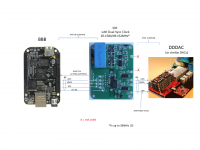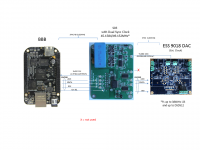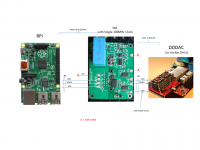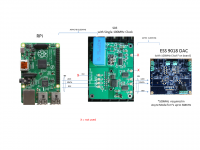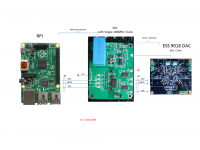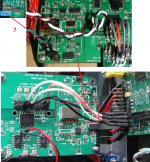Setup
I am planing to use the setup here below;
Usb Wfi->raspberry pi B (volumio) I2S->Acko AKL-S03 Digital Isolator & Re-clocker->Soren R-2R dac.
But the problem is i do not have any electronic knowledge, especially to choice proper transformer. I look at some manufacturer pages there are so many cables on the troidal transformers unlike 2 or 3 cable ac in 2 cable ac out.
I will need 3 troidal transformer, My country 220v main electricity
1) Power raspnerry pi over this 1.0uV Ultralow noise DAC power supply regulator 3.3V 5.0V 800mA - DIYINHK
regulator.
2) Power dac ( Dual 7-8V 5W )
3) Power Acko AKL-S03
Is there anyone tell me suitable/proper troidal transformers inside this manunufacturer web pages or any other....
Power Transformers Specs | Plitron
Toroidal Transformers and Power Converters From Avel Lindberg
Transformers - AnTek Products Corp
Best Regards...
I am planing to use the setup here below;
Usb Wfi->raspberry pi B (volumio) I2S->Acko AKL-S03 Digital Isolator & Re-clocker->Soren R-2R dac.
But the problem is i do not have any electronic knowledge, especially to choice proper transformer. I look at some manufacturer pages there are so many cables on the troidal transformers unlike 2 or 3 cable ac in 2 cable ac out.
I will need 3 troidal transformer, My country 220v main electricity
1) Power raspnerry pi over this 1.0uV Ultralow noise DAC power supply regulator 3.3V 5.0V 800mA - DIYINHK
regulator.
2) Power dac ( Dual 7-8V 5W )
3) Power Acko AKL-S03
Is there anyone tell me suitable/proper troidal transformers inside this manunufacturer web pages or any other....
Power Transformers Specs | Plitron
Toroidal Transformers and Power Converters From Avel Lindberg
Transformers - AnTek Products Corp
Best Regards...
Usb Wfi->raspberry pi B (volumio) I2S->Acko AKL-S03 Digital Isolator & Re-clocker->Soren R-2R dac.
Firstly, I would consider using a Beaglebone Black (BBB) with the TPA Botic driver software instead of the RPi. The RPi is more compromised than the BBB, especially with respect to clocking of the audio data and the BBB ought to deliver better results.
Acko's SO3 in combination with the Botic driver software allows the high quality clock crystals on the SO3 to clock the audio data on the BBB and includes a function to switch crystals so that 44.1KHz data isn't resampled to 48KHz. Acko explains it here;
http://www.diyaudio.com/forums/group-buys/227502-amanero-isolator-reclocker-gb-109.html#post3977819
and info about the clock options etc. for the SO3 are here (about halfway down on the right);
https://sites.google.com/site/ackodac/home
Cost difference between RPi and BBB is small, though BBB might be a little harder to obtain due to demand outstripping supply.
I'm currently working on a BBB/SO3 combination myself.
Power raspnerry pi over this 1.0uV Ultralow noise DAC power supply regulator 3.3V 5.0V 800mA - DIYINHK
regulator.
The normal recommendation for a RPi power supply is a minimum of 1A, which this supply falls short of. If there is insufficient power the RPi may not work properly. That said, if the RPi isn't going to loaded with peripherals this may be sufficient power.
The Beaglebone seems to have lower power requirements and I'm running mine on a linear power supply with a similar rating to the one you linked to. I checked the current being drawn by measuring the voltage across a resistor in the power line and applying Ohms law; it is typically around 400mA (peak at bootup is around 600mA but that is only for a short time). You could do the same check if you stick with the RPi.
3) Power Acko AKL-S03
You can't just connect the SO3 to a power transformer. You need at least two regulated power supplies upstream of the onboard LDO (low drop out) regulators. One power supply is needed on the source side of the input isolators and another one (or two if you want to go extreme) for the clock crystal supplies and output buffers. With the Beaglebone solution the source side of the isolators is powered from the Beaglebone (not sure if the RPi can do that?), otherwise a power supply like the one you linked to will be fine (set to 3.3V), with another for the clock/output sections of the SO3 (set to 5V). Personally, I'll be powering the clock and output sections with a Salas Reflektor D power supply. Acko also offers power supplies suitable for the SO3.
I suggest that before you worry about the specifics of the transformers you need to buy you need to think through what power supplies you need and decide which designs you will use, then you can specify the necessary transformers.
Most of this is off-topic with respect to Soren's DAC and so might be better relocated to Acko's SO3 thread?
I noticed you've signed up for Acko's SO3 bare board group buy on that thread; are you aware that this involves sourcing and then assembling small/delicate surface mounted components. Are you confident of doing that. Acko also supplies pre-assembled and tested SO3 boards.
For Soren's DAC, this transformer would seem to meet the stated requirement;
MCFM50/07 - MULTICOMP - TRANSFORMER, TOROIDAL, 2 X 7V | Farnell UK
Don't worry about the pictures of toroidal transformers with loads of wires coming out, they're normally just stock images that won't represent what you'll actually receive. The spec sheet will tell you what wires your transformer will have. I would expect the one I linked to above to have eight wires as follows;
Primary 1: 0-110V
Primary 2: 0-110V
Secondary 1: 0-7V
Secondary 2: 0-7V
Primary 1 and Primary 2 will be connected in series to give a single primary of 0-220V, suitable for your mains supply.
Hope that helps.
Ray
In the SR-2R  I don't think we have to bother about the clocks as the master clock is on the board itself close to the DAC. Electrical isolation from the outside (digi in / ana out) i.e. not dragging in a foul ground could be considered.
I don't think we have to bother about the clocks as the master clock is on the board itself close to the DAC. Electrical isolation from the outside (digi in / ana out) i.e. not dragging in a foul ground could be considered.
I would consider a switched power supply - they seem noisy but they still sound nice
//
I would consider a switched power supply - they seem noisy but they still sound nice
//
In the SR-2RI don't think we have to bother about the clocks as the master clock is on the board itself close to the DAC. Electrical isolation from the outside (digi in / ana out) i.e. not dragging in a foul ground could be considered.
I would consider a switched power supply - they seem noisy but they still sound nice
//
Agreed and I don't think I suggested otherwise; the Acko SO3 clocks have no part to play with Soren's DAC, where there is tight integration of the onboard clock with the processor and the fifo input. But in the context of
potstip's post the SO3 clocks would add value to the operation of a Beaglebone Black if he were to go that route instead of the RPi. Given the limitations of the RPi, which cannot use an external clock, and the fact that Soren's DAC has isolated inputs and reclocks its input via it's own fifo I'm not even sure the SO3 adds anything with the RPi?
Ray
Dear nautibuoy thanks for that great explanations,
I didnt know that i choose RPi over BBB because of 3 reason;
1) here http://bbb.ieero.com/ says that;
"By default the file is resampled if 44k1Hz frequency or multiples is being played. This might/will introduce hearable artifacts."
2) As fas as i know we can't use volumino if we use Miero linux image.
How you planing to play files? I can use BBB as you will do.
3) I read one of Sonren post the R-2R DAC use Asynchronous instead of synchronous and when i look at the attached pictures prepared by acko for BBB the connection is synchronous;
Actually the power consumption of RPI is 700ma according to google
And SO3 (200ma 5V x 3) or (200ma 5v x2 & 1x 3.3V)
I definatelly can't do that but there are so many electronic repair shops avaliable one of them could soldering components for me.
I do not go for fully assembled version because i am not sure that which version i need at the moment. Let me explain;
X1 and X2 slots can be filled depends on application, the standart build on Acko web page use big blue component but in application pictured sent by users do not include it. And components location could change. Please see attached 1.jpg picture.
but in application pictured sent by users do not include it. And components location could change. Please see attached 1.jpg picture.
Also in cutom builds some user use CCHD-950 and said that it is better. i have not enough experience to comment
Firstly, I would consider using a Beaglebone Black (BBB) with the TPA Botic driver software instead of the RPi. The RPi is more compromised than the BBB, especially with respect to clocking of the audio data and the BBB ought to deliver better results.
Acko's SO3 in combination with the Botic driver software allows the high quality clock crystals on the SO3 to clock the audio data on the BBB and includes a function to switch crystals so that 44.1KHz data isn't resampled to 48KHz. Acko explains it here;
I didnt know that i choose RPi over BBB because of 3 reason;
1) here http://bbb.ieero.com/ says that;
"By default the file is resampled if 44k1Hz frequency or multiples is being played. This might/will introduce hearable artifacts."
2) As fas as i know we can't use volumino if we use Miero linux image.
How you planing to play files? I can use BBB as you will do.
3) I read one of Sonren post the R-2R DAC use Asynchronous instead of synchronous and when i look at the attached pictures prepared by acko for BBB the connection is synchronous;
The normal recommendation for a RPi power supply is a minimum of 1A, which this supply falls short of. If there is insufficient power the RPi may not work properly. That said, if the RPi isn't going to loaded with peripherals this may be sufficient power.
The Beaglebone seems to have lower power requirements and I'm running mine on a linear power supply with a similar rating to the one you linked to. I checked the current being drawn by measuring the voltage across a resistor in the power line and applying Ohms law; it is typically around 400mA (peak at bootup is around 600mA but that is only for a short time). You could do the same check if you stick with the RPi.
Actually the power consumption of RPI is 700ma according to google
And SO3 (200ma 5V x 3) or (200ma 5v x2 & 1x 3.3V)
I noticed you've signed up for Acko's SO3 bare board group buy on that thread; are you aware that this involves sourcing and then assembling small/delicate surface mounted components. Are you confident of doing that. Acko also supplies pre-assembled and tested SO3 boards.
I definatelly can't do that but there are so many electronic repair shops avaliable one of them could soldering components for me.
I do not go for fully assembled version because i am not sure that which version i need at the moment. Let me explain;
X1 and X2 slots can be filled depends on application, the standart build on Acko web page use big blue component
Also in cutom builds some user use CCHD-950 and said that it is better. i have not enough experience to comment
Attachments
Any chance of switchable polarity inversion in the digital domain?
Probably, no big deal to implement....
I am planing to use the setup here below;
Usb Wfi->raspberry pi B (volumio) I2S->Acko AKL-S03 Digital Isolator & Re-clocker->Soren R-2R dac.
Any isolator or reclocking would be redundant as my R-2R DAC already have it....
My R-2R DAC can also output master clock if needed for t.ex. a USB interface.
It also seems the production gets a little further delayed as my precision resistor supplier recently told me:
"Unfortunately they had an unexpected defect rate with the original production run so are expediting a new batch now."
I have all other parts ready, except for the last precision resistors....
The positive is that the next batch will not be delayed and will therefore come shortly after the first batch.
"Unfortunately they had an unexpected defect rate with the original production run so are expediting a new batch now."
I have all other parts ready, except for the last precision resistors....
The positive is that the next batch will not be delayed and will therefore come shortly after the first batch.
1) here http://bbb.ieero.com/ says that;
"By default the file is resampled if 44k1Hz frequency or multiples is being played. This might/will introduce hearable artifacts."
That's right, 'out of the box' the Beaglebone has only a single onboard clock that will result in resampling of 44.1KHz family sampling rates. The SO3 essentially replaces the single onboard clock with the two higher quality clocks with automatic switching to the correct clock to avoid the resampling. One of the key benefits of miero's software, available on that link, is the clock switching. You can't do that with an RPi as far as I know.
2) As fas as i know we can't use volumino if we use Miero linux image.
How you planing to play files? I can use BBB as you will do.
No Volumio is a separate distribution to miero's. I will control what I play via a UPnP control point on my smartphone or tablet (BubbleUPnP). I've installed upmpdcli on top of miero's distribution so that it is visible as a upnp renderer. Chanh has also done this and is using it successfully with very good results.
http://www.diyaudio.com/forums/twisted-pear/258254-support-botic-linux-driver-22.html#post4115829
RuneAudio, which is similar to Volumio, are promising to include miero's software in their next BBB release.
3) I read one of Sonren post the R-2R DAC use Asynchronous instead of synchronous and when i look at the attached pictures prepared by acko for BBB the connection is synchronous;
The SO3 clocks need to control the BBB but the use of the the same clocks with the dac in full synchronous mode is optional. You wouldn't connect the SO3 clocks to Soren's DAC.
Actually the power consumption of RPI is 700ma according to google
I only related the raspberrypi.org recommendation.
I definatelly can't do that but there are so many electronic repair shops avaliable one of them could soldering components for me.
I do not go for fully assembled version because i am not sure that which version i need at the moment. Let me explain;
X1 and X2 slots can be filled depends on application, the standart build on Acko web page use big blue componentbut in application pictured sent by users do not include it. And components location could change. Please see attached 1.jpg picture.
Also in cutom builds some user use CCHD-950 and said that it is better. i have not enough experience to comment
I think you're worrying about things you don't need to worry about, for example, what relevance is whether pictures have a big blue component (its a capacitor) or not? Acko will build an SO3 to suit your needs with just the right components. I would suggest a pre-built SO3 with 40MHz family clocks will be fine for hooking up a BBB. As for whether CCHD-950, or whatever, is better or worse, consider your proposed application; you're only looking to use the SO3 to control the BBB and Soren's DAC has isolation and reclocking on its input and its (tightly integrated) clock will be more fundamental to the results than upgraded clocks on the SO3.
This is mostly off topic here and belongs in Acko's SO3 thread.
Ray
Any isolator or reclocking would be redundant as my R-2R DAC already have it....
My R-2R DAC can also output master clock if needed for t.ex. a USB interface.
Søren, in the context of Potstip's posts, I agree that the SO3 isolator/reclocker is superfluous with the input isolation and reclocking on your DAC board, but, it does have a use in providing external clocking to the Beaglebone so that there is no resampling of incoming data that its single onboard clock would otherwise dictate. With the RPi you're stuck with the resampling anyway.
Now, if the beaglebone could send its clock select flag to your dac and your dac could then switch to the correct clock rate for the data sampling rate and send a suitable clock signal back to the beaglebone.....
Ray
Søren, will the DA delay be deterministic in the sense that if I used say 2 for a four way system (dig XO), one for each channel, the inter channel (L/R) delay would be reasonably short and equal between channels, playing different songs, albums and samplerates / bit-depths?
I'm thinking about the buffer...
//
PS: Heja Danmark!!
I'm thinking about the buffer...
//
PS: Heja Danmark!!
Dear Soren
Correct me if i am wrong you design board 7-8v but we can also use 7-15v because all famous troidal transformer manufacturer use 6v then 9v.
So is there any disadvantage use 2 x 9VAC @ 0.83A, can i use this;
15VA Power Transformer
Physical:
3.2" x 5.8" (81 x 147 mm), two PCB mounted XLR connectors on one side for the balanced output driver.
Power:
Takes 2 x 7-15V DC or AC. Designed for single 2 x 7-8V 5W toroid transformer.
Correct me if i am wrong you design board 7-8v but we can also use 7-15v because all famous troidal transformer manufacturer use 6v then 9v.
So is there any disadvantage use 2 x 9VAC @ 0.83A, can i use this;
15VA Power Transformer
So is there any disadvantage use 2 x 9VAC @ 0.83A, can i use this;
15VA Power Transformer
The disadvantage is more waste heat as the dac regulators will have to 'burn' the extra voltage. As long as the regulator is able to dissipate the heat it'll be fine.
Ray
Potstip, you don't have to use a toroidal transformer, you could go with something like this;
https://www.reichelt.de/Transformer...3&LA=2&ARTICLE=2500&GROUPID=3317&artnr=4815-2
Ray
https://www.reichelt.de/Transformer...3&LA=2&ARTICLE=2500&GROUPID=3317&artnr=4815-2
Ray
There's a lot of useful information about Soren's DAC here;
R2R For The REST of US | H i F i D U I N O
Ray
R2R For The REST of US | H i F i D U I N O
Ray
Dear Soren
Correct me if i am wrong you design board 7-8v but we can also use 7-15v because all famous troidal transformer manufacturer use 6v then 9v.
So is there any disadvantage use 2 x 9VAC @ 0.83A, can i use this;
15VA Power Transformer
Multicomp MCFM50/07 yada MCFM70/07 lazimdir. Farnell bunlar satiyor.
- Home
- Vendor's Bazaar
- Reference DAC Module - Discrete R-2R Sign Magnitude 24 bit 384 KHz
